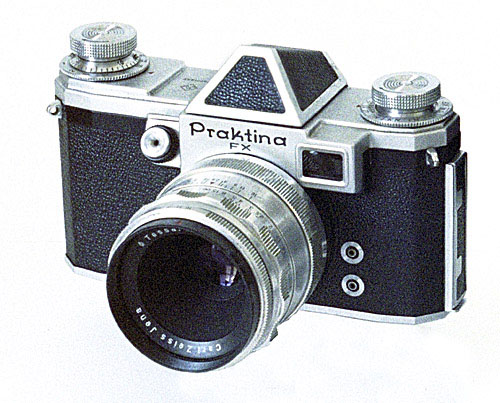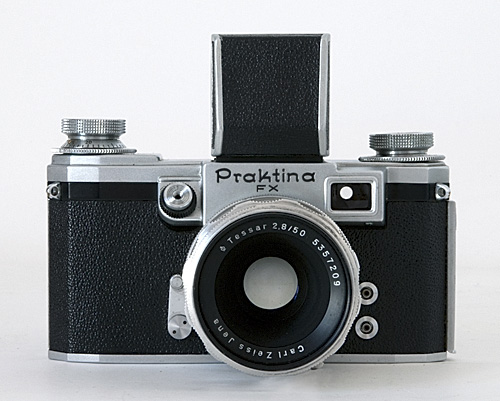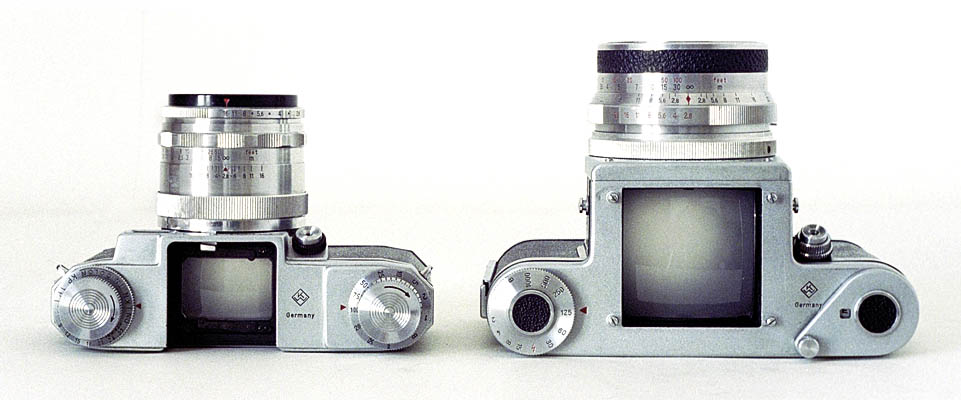by TRA
The History of the Pentacon Six
Detailed design principles
and solutions – the Praktina

The Praktina camera
[C444_9tina.jpg]
In a different suburb of Dresden, Niedersedlitz, a different camera company, Kamera-Werkstätten, was designing different 35mm single-lens reflex cameras, each with Prakti- as the first part of the name. “KW”, as it called itself on its logo, had been founded in 1919.
The new administration in the Soviet sector of Germany was run under orders from the Soviet Union, sometimes using as puppets German communists trained in the USSR over the course of the preceding decade or a little longer. It set about turning the Soviet-occupied sector of Germany into a communist state with a centralised economy that was claimed to be operating on Marxist principles. In 1946 the owners of KW were expropriated by order of the Soviet military administration (Hummel, p. 102), and the company was nationalised, being re-named VEB Kamera-Werkstätten Niedersedlitz. “VEB” stands for “Volks-Eigener Betrieb”, Newspeak for “Government-owned”. (The literal translation is “People’s Own Works”.)
The first post-war 35mm SLR from KW was a slightly-modified version of its 1939 Praktiflex, produced in 1947 with a 40mm × 1 screw thread lens mount. (Hummel, p. 115). A year later, the Praktica was launched, with a 42mm × 1 screw thread lens mount, but no prism.
| The Praktina
In 1952, KW introduced the Praktina, a 35mm SLR with many innovative features. It was warmly welcomed by many sectors, among them professionals in many branches of science and technology. It was also commercially successful: about 10,000 were sold. Following further reorganisation, VEB Kamera-Werkstätten was re-named VEB Kamera-Werke Niedersedlitz. In 1954, the Praktina FX was launched. It
standardised the flash synchronisation sockets. Nearly 67,000 were
sold, over 60% of them to export markets, reports Hummel (p. 217).
In 1958, the Praktina IIa introduced the now-customary geometrical progression of shutter speeds (1/60, 1/125, 1/250, 1/500, etc, instead of the previous 1/100, 1/200, 1/500, etc) and a single flash socket. Over the next two years, nearly 25,000 of these cameras were sold, before the sudden decision was taken to abandon production and concentrate instead on the Praktica range of cameras. (Hummel, p.217) The Praktina was advertised as having seven interchangeable components – although this included a filter thread on the lenses! Other interchangeable elements were:
|

At the time of the introduction of the Praktina, the debate between users of rangefinder camera and SLRs was in full swing. Those who preferred a rangefinder camera said that with the SLR the viewfinder went blank at the precise moment that you took the photo. KW responded by including a direct-vision finder in their new 35mm SLR. It gave a bright, clear and uninterrupted image, which could of course however only cover the field of view of one lens. They designed it to show the same as a 50mm lens. |
The Praktinas had a breech-lock bayonet lens mount, which by 1956 incorporated an internal lever to stop down the aperture of the lens automatically just before the shutter was fired.
Accessories included two different types of motor drive (one electrical, the other using a spring that could be wound up), a 17m film back that enabled 450 exposures to be made, bellows, extension tubes, waist-level, magnifying and prism finders (one with an external light meter), microscope attachments, specialist accessories for medicine, astronomers and scientists in many fields, electric and radio-controlled firing of the shutter (which, with an attached motor drive, could be re-cocked for the next shot).
In short, the Praktina represented the pinnacle of camera design at the time. It was the Praktina that provided the world-wide market success and the technical solutions that led to the production of the KW’s first medium format SLR in 1956.

Top view of the Praktina, next to the larger brother that soon followed
on from it.
[C404_34.jpg]
To go to the Bibliography, click here.
To go on to the next section, click below.
15 The new KW Medium Format SLR
camera: choosing a name
To go to the beginning of the history section, click here.
To go to introduction to the cameras, click here.
To choose other options, click below.
Home
© TRA August 2010